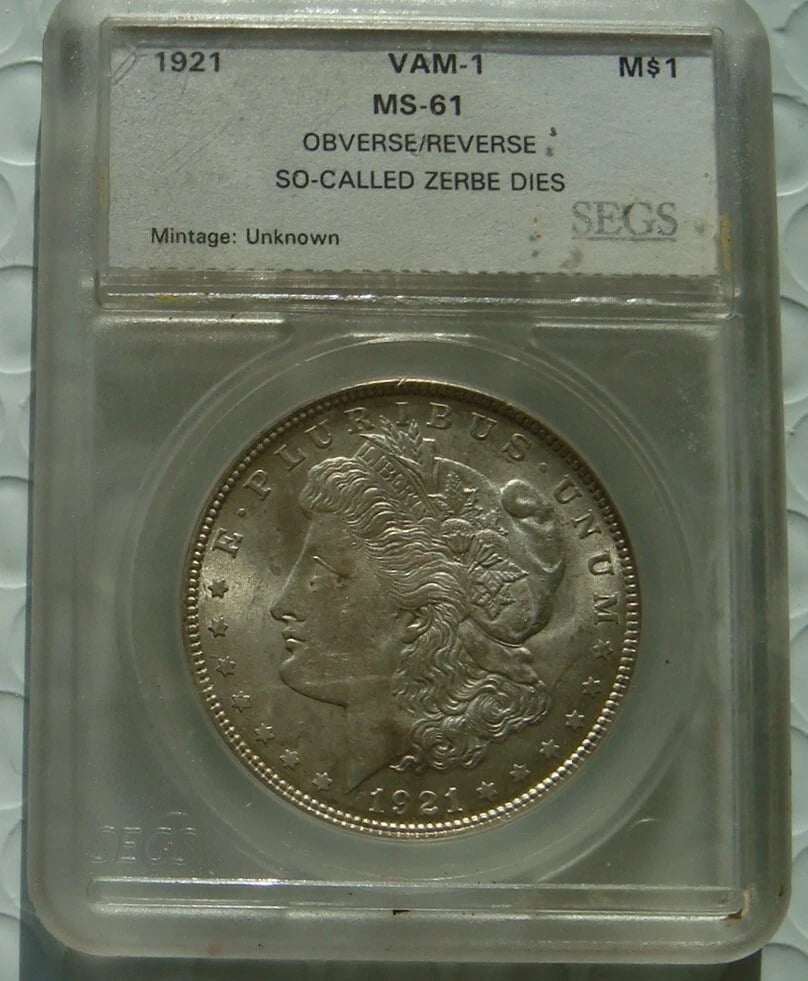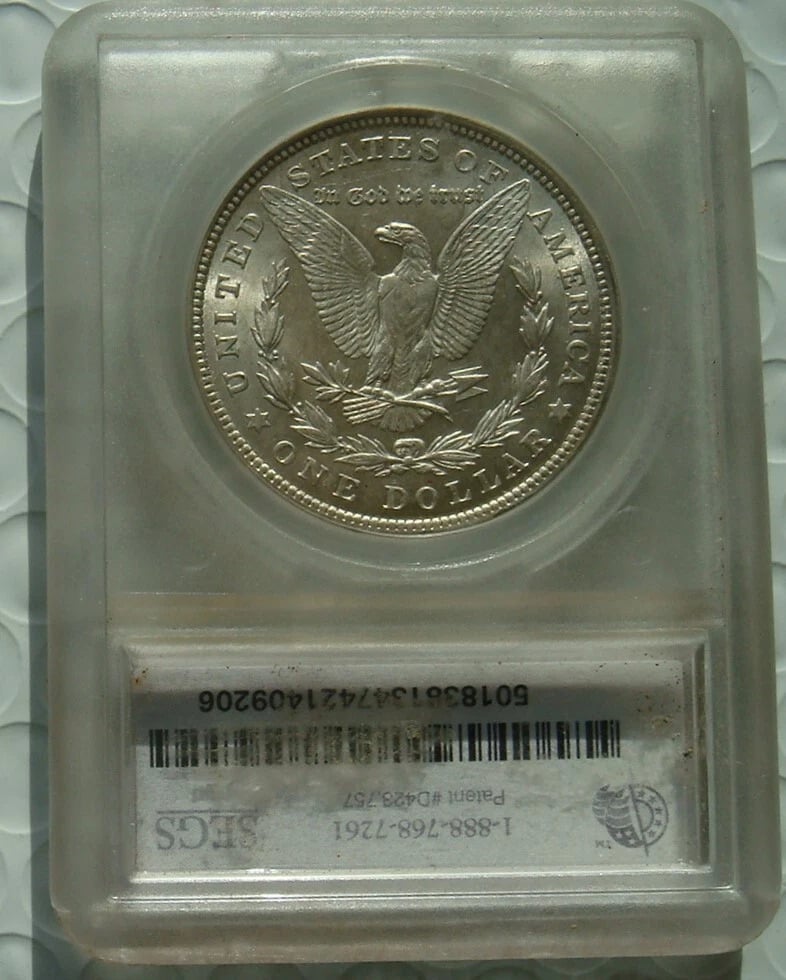Segs 1921 So-called Zerbe dollar
 logger7
Posts: 9,210 ✭✭✭✭✭
logger7
Posts: 9,210 ✭✭✭✭✭


I'm assuming this is nothing special.
0
 logger7
Posts: 9,210 ✭✭✭✭✭
logger7
Posts: 9,210 ✭✭✭✭✭


I'm assuming this is nothing special.
Comments
Tough call in that holder.
It doesn't look like a Zerbe coin to my eyes but the photos aren't the best. I would, however, expect a better strike and a more PL coin.
All comments reflect the opinion of the author, even when irrefutably accurate.
All comments reflect the opinion of the author, even when irrefutably accurate.
Not a Zerbe dollar in my opinion. Just a regular mint state coin.
Proud follower of Christ!
Here is the VamWorld page for the Zerbe dies that has some information on them and including the 'so-called' ones. Additional (update) information near bottom of link page on the Zerbe VAMs or not.
https://vamworld.com/wiki/Zerbe_Dies
https://youtube.com/watch?v=hYCRaWPlTIE Sophie Lloyd, guitar shred cover of Panama (Van Halen)
https://youtube.com/watch?v=dOV1VrDuUm4 Ted Nugent, Hibernation, Live 1976
RLJ 1958 - 2023
I don't think it is a Zerbe dollar, it is SEGS.
Zerbe dies does not equal Zerbe dollar. Just like a Vam-1H does not equal a proof Peace Dollar.
That holder just says its from the same set of dies.
Collector, occasional seller
The use of the term “Zerbe dollar” in the thread title is ambiguous and has caused some confusion.
There are so-called “Zerbe” Proofs, but there there are also normal business strikes from ”Zerbe Dies”.
Here’s an example of the latter, an ANACS MS63 that brought $54 in December of 2023:
https://coins.ha.com/itm/morgan-dollars/1921-1-vam-1ag-ms63-anacs-zerbe-proof-dies-mintage-44-690-000-pcgs-7296-/a/63257-93923.s?ic4=ListView-ShortDescription-071515
Auction 63257 | Lot 93923 » Silver and Related Dollars » Morgan Dollars
1921 $1 VAM-1AG MS63 ANACS. "Zerbe Proof" dies. Mintage 44,690,000. (PCGS# 7296)
SERVICE
ANACS
GRADE
MS63
AUCTION ENDED
Dec 26, 2023
Mark Feld* of Heritage Auctions*Unless otherwise noted, my posts here represent my personal opinions.
I don't know but I like the SEGS holders. Apparently, Mr. Briggs put a lot of time, money, research and effort into them.
Disclaimer: I'm not a dealer, trader, grader, investor or professional numismatist. I'm just a hobbyist. (To protect me but mostly you! 🤣 )
First agree that there are Zerbe and business strike from Zerbe Dies. But this appears a little more complicated at least to me. From the link I provided above it has the 'so-called Zerbe die' title for a particular VAM (not a Zerbe Proof). Also the OP coin is graded as MS and not PR or SP.
"Similar coins were made for circulation. These "SO-CALLED ZERBE DIE" coins do not have the mark at UNUM.
1921-P VAM-1 is the "SO-CALLED ZERBE DIE" variety."
The link also mentions so-called Chapman Proofs. Unfortunately using the words so-called to identify the Proof. So I would assume that the so-called Zerbe Proof is also used for the Proof. The OP is a 'so-called Zerbe die'.
"Additionally. a second proof variety was struck. The second Proof version is the so-called "Chapman" Proof, named after the Philadelphia coin dealer, Henry Chapman. "
The VAM-1AG that MFeld provided a HA link to (as a MS) is also listed in the previous VAMWorld link but going to the VAM-1AG there is this photo showing the VAM-!AG graded as a SP. If I follow this, then it is a matter of when it was struck and some die markers? But is the same VAM number potentially a MS and/or a SP or something else happening?
https://vamworld.com/wiki/1921-P_VAM-1AG
I will aslo note again that there have been updates to the VAMWorld on various discoveries (as previously noted) and found in the link or the other VAM links. I didn't try to follow it all so this might be some of what is going on.
@messydesk Any input on this and what I have probably missed?
https://youtube.com/watch?v=hYCRaWPlTIE Sophie Lloyd, guitar shred cover of Panama (Van Halen)
https://youtube.com/watch?v=dOV1VrDuUm4 Ted Nugent, Hibernation, Live 1976
RLJ 1958 - 2023
Without going into the controversy of what "Zerbe Proof" means, there was confusion 20-25 years ago surrounding identifying the dies used to make those coins. There was a statement made that the Zerbe coins had horizontal scratches on the top arrowhead. Misunderstandings led to the assumption that if the arrow had those scratches, it was from the "Zerbe Proof" dies (the converse of the original statement). This information ended up on SEGS holders quickly and has proven to be a hard bell to unring. The scratches are a feature of the D1 reverse master hub, which accounts for about 25% of all 1921-P Morgans (no D or S Morgans used this hub), not just the "Zerbe Proof" dies, which are VAM 1AG.
Keeper of the VAM Catalog • Professional Coin Imaging • Prime Number Set • World Coins in Early America • British Trade Dollars • Variety Attribution
These dies were used for normal business strikes as well as the coins that have been graded as "Zerbe proofs". The same VAM number is used for both. Likewise, the 1921-S "Zerbe Proof" VAM 35. There's no record of the special coins having been made and no record of Zerbe storming the mint and demanding coins. They're not as proofy as the Chapman proofs, but they definitely look like there was a non-standard process surrounding their manufacture.
Keeper of the VAM Catalog • Professional Coin Imaging • Prime Number Set • World Coins in Early America • British Trade Dollars • Variety Attribution
>
The “Chapman” Proofs look like what’s expected for a Proof Morgan dollar (of any date). They’re brilliant and obvious Proofs.
On the other hand, the “Zerbe” Proofs are controversial. Some numismatists (including Q. David Bowers) doubt that the coins were struck as Proofs. Instead, they believe that the coins were likely early strikes from business strike dies.
Here’s a “Zerbe Proof” auctioned by Heritage this past April for $33,600. Compare that price to what the lower grade “Chapman Proof” linked below it, brought.
https://coins.ha.com/itm/proof-morgan-dollars/1921-1-zerbe-pr66-pcgs-cac-pcgs-7341-/a/1382-3094.s?ic4=ListView-ShortDescription-071515
“Description
1921 Morgan Dollar, PR66
Zerbe Proof, Among the Finest at PCGS
CAC Endorsed
1921 $1 Zerbe PR66 PCGS. CAC. The 1921 Zerbe proofs are a controversial issue among numismatists today. The traditional story is that a number of proof Morgan dollars were struck late in 1921 to mollify Farran Zerbe, and other collectors, because the debut of the Peace dollar was so long delayed. However, in his Guide Book of Morgan Silver Dollars, Q. David Bowers casts doubt on this story, evaluating the Zerbe proofs as simply prooflike regular-issue coins. Bowers states:
"It seems highly unlikely that these were produced as Proofs for collectors. If indeed they were furnished to Farran Zerbe, a leading numismatic entrepreneur of the era, it is likely they were simply regular production pieces."
The controversy is far from settled today, and the grading services have certified numerous examples as Zerbe proofs, siding with the traditional view of the issue. The VAM website assigns a single die pair as the Zerbe proof dies (VAM-1AG), including examples in different die states. The present coin displays slightly cloudy reflective fields, as seen on all Zerbe coins. A tiny reeding mark on Liberty's chin hollow pedigrees this Premium Gem example. The strike is razor-sharp on the hair above the ears and the wreath, also typical of this issue. The pleasing surfaces display a few hints of gold toning. PCGS Population: 13 in 66 (2 in 66+), 0 finer. CAC: 5 in 66, 0 finer (2/25).
Ex: Chicago Signature (Heritage, 8/2011), lot 7380; FUN Signature (Heritage, 1/2014), lot 5342.(Registry values: N4719)
From The Cherry Villa Collection.
Coin Index Numbers: (NGC ID# 257A, PCGS# 7341, Greysheet# 7871)
Weight: 26.73 grams
Metal: 90% Silver, 10% Copper
View all of [The Cherry Villa Collection ]”
And here’s a “Chapman Proof” that was auctioned by Heritage in August of last year for $96,000.
https://coins.ha.com/itm/proof-morgan-dollars/1921-1-chapman-pr64-cameo-pcgs-cac-pcgs-87342-/a/1376-4040.s?ic4=ListView-ShortDescription-071515
“1921 Morgan Dollar, PR64 Cameo
Rare Chapman Proof
Sole Certified Cameo Example
1921 $1 Chapman PR64 Cameo PCGS. CAC. The always-elusive Chapman proof Morgan dollars are believed to be the result of a clandestine transaction between coin dealer Henry Chapman and Chief Engraver George T. Morgan that took place late in 1921. While the mintage is uncertain, Chapman proofs are decidedly rare. Walter Breen reported 12 pieces struck, while Q. David Bowers estimates a production of 30 coins. The grading services report a surprisingly large number of examples, possibly due to resubmissions and crossovers -- but only this single Cameo coin.
The Chapman proofs are distinguished from their Zerbe counterparts by the deeply mirrored quality of their fields, as well as a unique die pair that defines all true Chapman proofs. This spectacular Choice example shows distinct elements of contrast between the reflective fields and the frosty devices, much like the Morgan dollar proofs of the 1890s. Only a few minor hairlines and contact marks are evident, with a few hints of light golden toning.
Acceptance of the 1921 Chapman proofs has increased dramatically over the past 20 years. Their high quality surfaces and beautiful eye appeal has endeared the issue with Morgan dollar collectors. Much as the 1921 PDS Morgan dollars are part of the series, the Chapman proofs are collected with increasing interest as time passes. Most Morgan proof collectors seek an outstanding example.
This is an exceptional near-Gem Chapman proof. It displays the requisite die lines and markers to confirm its origins: A short line from the rim points to the third star, light die scratches above the first T in STATES, and a die line in the field between the wreath and right star. Faint golden-gray patina dapples glassy-mirrored fields, enhancing the contrast with well-frosted central elements. The strike is representative of the 1921 dies, with a touch of high-point softness over the ear.
This coin remains the only Cameo Chapman proof certified by either PCGS or NGC (5/24). CAC endorsement adds to the coin's resume. We expect strong competition when this flashy, contrasted proof crosses the auction block.
Ex: Paul Taylor Collection; Chicago Signature (Heritage, 8/2011), lot 7381; The Lonestar Collection of Mint State and Proof Morgan Dollars; Central States Signature (Heritage, 4/2021), lot 5086.
From The Benedict Family Collection.
Coin Index Numbers: (PCGS# 87342, Greysheet# 7873)
Weight: 26.73 grams
Metal: 90% Silver, 10% Copper
View all of [The Benedict Family Collection ]”
Mark Feld* of Heritage Auctions*Unless otherwise noted, my posts here represent my personal opinions.
Thanks, I was thinking it was something in the updates that was a little bit confusing to me. That clears it up.
On the other there were so many different 'markers' mentioned that I was not certain that the dies were then used for business strike and the same VAM but you confirmed that they were.
I also noticed a similar thing for the https://vamworld.com/wiki/1921-P_VAM-3BV in the notes.
I relate this to be similar to these unofficial branch mint proofs where production dies were 'polished up'.
@MFeld thanks for the additional information. I was aware of the differences between the Zerbe (or should I say so-called Zerbe) and the Chapman from some of my readings when doing Morgan dollars. But a little more information never hurts.
https://youtube.com/watch?v=hYCRaWPlTIE Sophie Lloyd, guitar shred cover of Panama (Van Halen)
https://youtube.com/watch?v=dOV1VrDuUm4 Ted Nugent, Hibernation, Live 1976
RLJ 1958 - 2023
@lilolme (or if you prefer, lilolyou 😉) I figured you were probably familiar with the differences between the “Zerbe” and “Chapman” coins, as your posts indicate that you’re extremely studious and information/detail oriented. And that’s meant as a sincere compliment.
I posted what I did in reply to your post, as that looked like a logical place to get the information out to others who might not be aware of the differences.
Mark Feld* of Heritage Auctions*Unless otherwise noted, my posts here represent my personal opinions.
I didn't realize that Heritage sold Anacs coins.